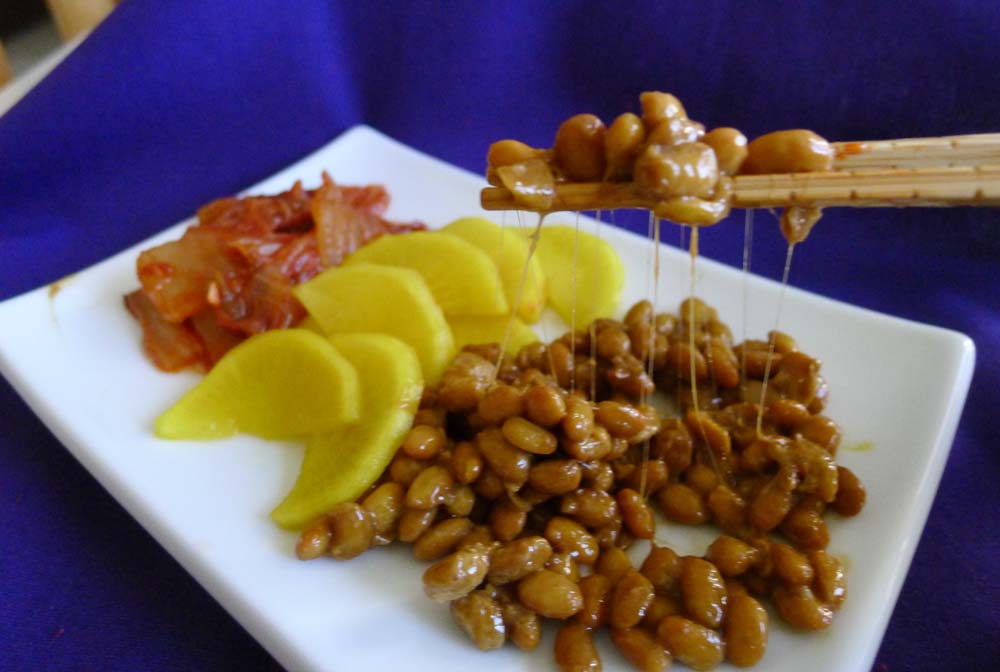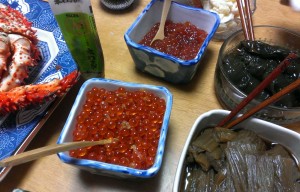19 Jun Growing up with stinky, slimy, altogether wonderful Japanese food
I’m a foodie. Everyone knows this. I write about food, I take photos of food everywhere I dine, I love to cook, and I love food from everywhere. One of my personal rules has always been, if someone somewhere in the world eats something, I’m willing to try it… at least once.
So I’ve had chocolate covered ants. Fried grubs. The meat of some strange animals that you wouldn’t think humans ought to eat, like rattlesnake brats.
In a way, I was prepared for this gastronomic open-mindedness (open-stomachnes?) by growing up Japanese. I was raised in Japan until I was 8, but even lifelong Japanese Americans know what I mean when I say that Japanese cuisine — although hailed today as the epitome of high culture and is accepted as mainstream with commonplace dishes like sushi, ramen, tempura, sukiyaki and teriyaki – can feature some nasty stuff.
Foul-smelling, slimy and icky-textured. Food that’s best swallowed quickly, without chewing or thinking about. No savoring the flavor, just pop it in and send it down the chute.
A lot of people probably would disagree with me, but I feel that way about oysters. I think they’re gross. Keeping my personal rule in mind, I’ll eat them if I’m at a nice restaurant in a town like Boston, where oysters are de rigeur. But I won’t seek them out and suggest an oyster bar for a night out.
It’s ironic, then, that people who would slurp down an oyster at a moment’s notice would probably themselves grossed out at some things I love: Raw eggs mixed with soy sauce and drizzled on hot rice; natto (fermented soy beans) mixed with soy sauce and mixed with hot rice; crunchy takuan; oden, an odiferous winter stew.
Natto in particular seems to turn off lots of Japanese in Japan as well as stateside. I’m told natto stinks, though I’ve never felt offended by its odor. People say it smells like dirty feet, but durian – the ugly, spiny fruit of Southeast Asia – smells much more like dirty feet than natto. But more than the smell, people think natto is yucky because of its slimy, snotty texture. From fermentation, the soy beans are coated with a transparent film that can evokes the slimy coating of the creatures in the “Alien” movies. But you know what? Natto is one of the most healthy foods you can eat. (Not so much the white rice you’d mix it with, however….)
Takuan is a side dish I grew up with, one of the myriad of “tsukemono” or pickled and prepared vegetables that are served alongside traditional Japanese dishes. Takuan is just pickled daikon radish. It’s usually bright yellow, from the addition of ground turmeric, and tastes sweet and salty, and crunches when you eat it. But when you just smell it, it stinks to high heaven.
My wife Erin has a wonderfully easy family recipe for making takuan, so every couple of months she makes a big bowl of it and puts it in five or six jars for my mom, who eats a few pieces with every meal. Once it’s made we let it set overnight on the kitchen counter, then I try to get the jars to my mom’s house right away because it stinks up the whole house, and my car too. For the next couple of months, every time my mom opens her refrigerator door, it smells like something crawled in there and died.
It tastes great, though, and unlike natto, there’s no yucky texture to deal with!
Another favorite stinky dish is kimchee, or fermented cabbage with red chili pepper powder and garlic, a Korean staple that my mom used to make years ago, and that Erin and I have been making the past year as we’ve gotten into fermenting food (warning: a lot of fermenting means a lot of stinky food).
Kimchee is made primarily using napa cabbage, but you can also make it with cucumbers and faikon. The daikon by itself is intensely pungent, but making it into kimchee raises the odor level several notches.
Japanese love daikon radish. When we visited my uncle and aunt in the small fishing town of Nemuro a few years ago, it was daikon harvest season, and every home in town had a rack in the yard with more than a dozen – sometimes several dozen – daikon strung up to dry. Once they shrivel up, they’re cut and used for various side dishes including takuan.
We also grate daikon and glop it on top of fish or meat, adding that layer of unmistakable odor to the tastiness of the protein underneath. With soy sauce added, it’s pretty darned delicious!
Japanese also eat mountain yam, or Yamaimo (or Nagaimo), which isn’t stinky and practically has no taste, but when sliced and grated turns into a mucus-y slime that can be mixed with soy sauce and drizzled over rice or served with noodles. I wonder sometimes why the first Japanese to eat such a plant would think to try it this way.
I haven’t had it but many older Japanese Americans recall growing up eating Homyu, a Cantonese dish that’s a smelly mix of salted fish and steamed pork. I see there are some Chinese and Japanese restaurants in the LA area that still serve it so I’ll eventually give it a try.
To show my Japanese bona fides, other foods I like that I bet my non-Japanese friends would run screaming from:
- Ikura, or salmon roe – I had the freshest ikura ever last year at my aunt and uncle’s house in Nemuro, on the northern Japanese island of Hokkaido. It was bright red and popped with an oily burst that wasn’t the least bit fishy.
- Seaweed paste – This is a gloppy salty dark green/blackish paste out of a jar that you mix in with rice. It adds a sodium hit that makes white rice very tasty.
- Konnyaku – A gelatin-like substance that can be called “food” because you eat it, but it has no flavor or calories or nutritional value, just a chewiness to it. It’s made of a type of yam, or taro plant, and has seaweed added to it (I guess for nutritional oomph?), and is found as an ingredient in stews like oden. It’s usually a dead-flesh gray color with speckles, and is sometimes made into noodles.
Growing up, my mom used to cook the family western-style dinners like steak, burgers, or even spaghetti, but she often would cook a Japanese meal for herself, and that meal would often be salted salmon pan-fried, with rice and tsukemono (pickled vegetable side dishes) such as takuan, or maybe kimchee. This was my food culture as a child.
I bet it was the food culture in many Japanese American homes, even in the years after WWII when many families tried to underplay their Japaneseness, because food culture is one of our strongest ties to the past, and to our community.
Now that japanese cuisine has become mainstream in the U.S., I think it’s good remember the unique dishes we grew up with that Americans probably would be grossed out by. Those are the cultural touchstones that remind us of our Japanese heritage.
Then again, it’s all relative. When I was a kid, my white friends in school would tease me about stuff like sushi and sashimi. “Eeeeuuw, you eat raw fish? That’s gross!” Even until the 1980s and ’90s, sushi was not commonplace in my white surburban geography. Maybe in LA or San Francisco, but not in Denver.
Now those kids have grown up and I bet they eat sushi at least once a month. Sushi’s available everywhere, not just at Japanese restaurants but at many Chinese and “Asian fusion” restaurants too, and even at most supermarkets.
I know one Caucasian woman who eats sushi at least once a week. Hell, I can’t even afford to do that.
But in a world where Japanese food has become commonplace, there are still Japanese dishes that are not. Here’s to all the slimy and smelly foods that make up my culinary DNA!
(NOTE: a shorter version of this post ran in the Pacific Citizen, the national newspaper of the JACL.)






